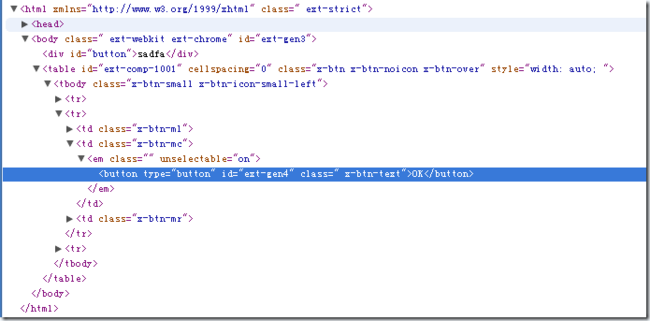renderTo和applyTo的区别
Extjs的组件有两个看起来类似的配置项,applyTo和renderTo,这两个配置项都是用来指定将该extjs组件加载到什么位置。那他们到底有什么区别呢?
个人认为这两篇文章写的不够通俗。
写一个简单的例子来看看最终生成了什么代码。
<head>
<title>RenderTo and ApplyTo</title>
<link rel="Stylesheet" type="text/css" href="ext-3.1.0/resources/css/ext-all.css" />
<script type="text/javascript" src="ext-3.1.0/adapter/ext/ext-base-debug.js"></script>
<script type="text/javascript" src="ext-3.1.0/ext-all-debug.js"></script>
<script type="text/javascript" src="ext-3.1.0/src/locale/ext-lang-zh_CN.js"></script>
<script type="text/javascript">
Ext.onReady(function() {
var button = new Ext.Button({
renderTo: 'button',
text:'OK'
});
});
</script>
</head>
<body>
<div id="button">sadfa</div>
</body>
</html>
很明显,简单的说,applyTo是将组件加在了指定元素之后,而renderTo则是加在指定元素之内。
接下来,我们再稍稍探寻下extjs源码的奥秘。看看extjs内部是如何使用这两个配置项的,利用firebug插件调试一下ext-all-debug.js这个文件。在Ext.Component的构造函数Ext.Component = function(config){…}中有这样一段代码(3.1.0版本是9270行):
if(this.applyTo){
this.applyToMarkup(this.applyTo);
delete this.applyTo;
}else if(this.renderTo){
this.render(this.renderTo);
delete this.renderTo;
}
可见applyTo属性使得Component调用applyToMarkup方法,而renderTo使得它调用render方法,并且如果两个都设置的话仅有applyTo有效,这点在extjs的文档中也有特别指出。
appylToMarkup方法如下(3.1.0版本是9560行)
applyToMarkup : function(el){
this.allowDomMove = false;
this.el = Ext.get(el);
this.render(this.el.dom.parentNode);
}
它最终调用的也是render,不过render的位置是parentNode,render方法如下(3.1.0版本是9370行)
render : function(container, position){
if(!this.rendered && this.fireEvent('beforerender', this) !== false){
if(!container && this.el){
this.el = Ext.get(this.el);
container = this.el.dom.parentNode;
this.allowDomMove = false;
}
this.container = Ext.get(container);
if(this.ctCls){
this.container.addClass(this.ctCls);
}
this.rendered = true;
if(position !== undefined){
if(Ext.isNumber(position)){
position = this.container.dom.childNodes[position];
}else{
position = Ext.getDom(position);
}
}
this.onRender(this.container, position || null);
if(this.autoShow){
this.el.removeClass(['x-hidden','x-hide-' + this.hideMode]);
}
if(this.cls){
this.el.addClass(this.cls);
delete this.cls;
}
if(this.style){
this.el.applyStyles(this.style);
delete this.style;
}
if(this.overCls){
this.el.addClassOnOver(this.overCls);
}
this.fireEvent('render', this);
var contentTarget = this.getContentTarget();
if (this.html){
contentTarget.update(Ext.DomHelper.markup(this.html));
delete this.html;
}
if (this.contentEl){
var ce = Ext.getDom(this.contentEl);
Ext.fly(ce).removeClass(['x-hidden', 'x-hide-display']);
contentTarget.appendChild(ce);
}
if (this.tpl) {
if (!this.tpl.compile) {
this.tpl = new Ext.XTemplate(this.tpl);
}
if (this.data) {
this.tpl[this.tplWriteMode](contentTarget, this.data);
delete this.data;
}
}
this.afterRender(this.container);
if(this.hidden){
this.doHide();
}
if(this.disabled){
this.disable(true);
}
if(this.stateful !== false){
this.initStateEvents();
}
this.fireEvent('afterrender', this);
}
return this;
}
render的方法看起来相当的复杂,仔细阅读也能理解个大概,主要是为一个DOM节点设置class,可见性,在onRender方法中生成相应的HTML代码。
个人认为:el是紧紧包裹EXT组件的一个DOM节点,一般是由EXT自己生成,好像细胞膜一样,如果拨开了它,那么整个组件就显示的不完整,很可能显示的不正常。而render中的container(也就是applyTo的父原始,renderTo中的指定元素),是该组件的父元素,这个container可以是HTML代码,亦或是EXT组件。
综上所述:applyTo和renderTo没有本质上的区别,只是renderer的位置不同。

